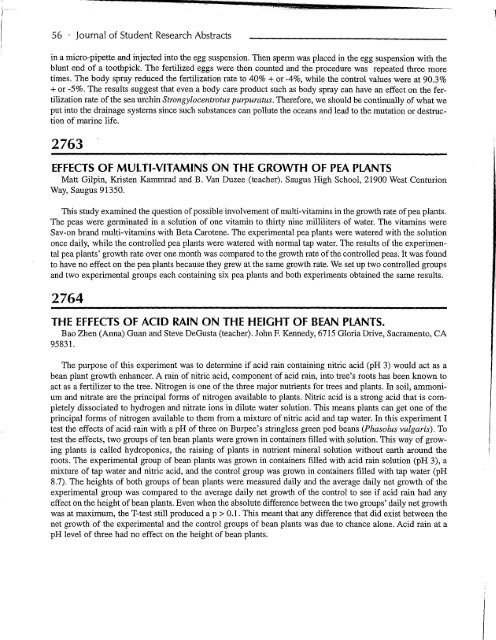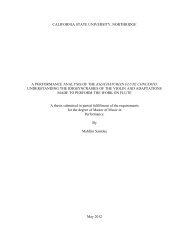2644 - CSUN ScholarWorks - California State University, Northridge
2644 - CSUN ScholarWorks - California State University, Northridge
2644 - CSUN ScholarWorks - California State University, Northridge
Create successful ePaper yourself
Turn your PDF publications into a flip-book with our unique Google optimized e-Paper software.
56 · Journal of Student Research Abstracts<br />
in a micro-pipette and injected into the egg suspension. Then sperm was placed in the egg suspension with the<br />
blunt end of a toothpick. The fertilized eggs were then counted and the procedure was repeated three more<br />
times. The body spray reduced the fertilization rate to 40% +or -4%, while the control values were at 90.3%<br />
+or -5%. The results suggest that even a body care product such as body spray can have an effect on the fertilization<br />
rate of the sea urchin Strongylocentrotus purpuratus. Therefore, we should be continually of what we<br />
put into the drainage systems since such substances can pollute the oceans and lead to the mutation or destruction<br />
of marine life.<br />
2763<br />
EFFECTS OF MULTI-VITAMINS ON THE GROWTH OF PEA PLANTS<br />
Matt Gilpin, Kristen Kamrnrad and B. Van Duzee (teacher). Saugus High School, 21900 West Centurion<br />
Way, Saugus 91350.<br />
This study examined the question of possible involvement of multi-vitamins in the growth rate of pea plants.<br />
The peas were germinated in a solution of one vitamin to thirty nine milliliters of water. The vitamins were<br />
Sav-on brand multi-vitamins with Beta Carotene. The experimental pea plants were watered with the solution<br />
once daily, while the controlled pea plants were watered with normal tap water. The results of the experimental<br />
pea plants' growth rate over one month was compared to the growth rate of the controlled peas. It was found<br />
to have no effect on the pea plants because they grew at the same growth rate. We set up two controlled groups<br />
and two experimental groups each containing six pea plants and both experiments obtained the same results.<br />
2764<br />
THE EFFECTS OF ACID RAIN ON THE HEIGHT OF BEAN PLANTS.<br />
Baa Zhen (Anna) Guan and Steve DeGusta (teacher). John F. Kennedy, 6715 Gloria Drive, Sacramento, CA<br />
95831.<br />
The purpose of this experiment was to determine if acid rain containing nitric acid (pH 3) would act as a<br />
bean plant growth enhancer. A rain of nitric acid, component of acid rain, into tree's roots has been known to<br />
act as a fertilizer to the tree. Nitrogen is one of the three major nutrients for trees and plants. In soil, ammonium<br />
and nitrate are the principal forms of nitrogen available to plants. Nitric acid is a strong acid that is completely<br />
dissociated to hydrogen and nitrate ions in dilute water solution. This means plants can get one of the<br />
principal forms of nitrogen available to them from a mixture of nitric acid and tap water. In this experiment I<br />
test the effects of acid rain with a pH of three on Burpee's stringless green pod beans (Phasolus vulgaris). To<br />
test the effects, two groups of ten bean plants were grown in containers filled with solution. This way of growing<br />
plants is called hydroponics, the raising of plants in nutrient mineral solution without earth around the<br />
roots. The experimental group of bean plants was grown in containers filled with acid rain solution (pH 3), a<br />
mixture of tap water and nitric acid, and the control group was grown in containers filled with tap water (pH<br />
8.7). The heights of both groups of bean plants were measured daily and the average daily net growth of the<br />
experimental group was compared to the average daily net growth of the control to see if acid rain had any<br />
effect on the height of bean plants. Even when the absolute difference between the two groups' daily net growth<br />
was at maximum, the T-test still produced a p > 0.1. This meant that any difference that did exist between the<br />
net growth of the experimental and the control groups of bean plants was due to chance alone. Acid rain at a<br />
pH level of three had no effect on the height of bean plants.<br />
l













